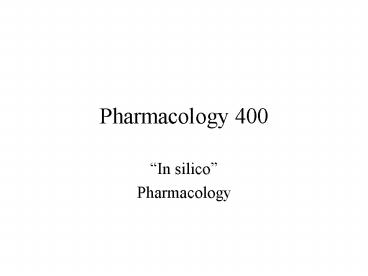Pharmacology 400 - PowerPoint PPT Presentation
1 / 23
Title:
Pharmacology 400
Description:
Replacement of an intracellular loop of the b2-adrenergic receptor with ... Structure of the human b2-adrenergic receptor (blue) embedded in a lipid ... – PowerPoint PPT presentation
Number of Views:39
Avg rating:3.0/5.0
Title: Pharmacology 400
1
Pharmacology 400
- In silico
- Pharmacology
2
- Dynamics
- Kinetics
- Drug Development
3
Dynamics
Curve-fitting and modelling of agonist,
antagonist, inverse agonist, And ligand-binding
studies.
4
Kinetics
Distribution and elimination of drugs.
Similarly, with intoxicants (poisons), although
this may include very long-term studies and Very
low levels of exposure. See FDA regulations on
environmental carcinogens ( baseline limit is
one extra cancer per 1,000,000 persons exposed
over 70 year lifetime ).
5
Drug Development
Principal use of computing in pharmacology and
therapeutics. Structure-Activity studies and,
increasingly, high-speed screening and expert
systems for specialist study during development,
e.g., metabolism and bioavailability.
6
(No Transcript)
7
(No Transcript)
8
(No Transcript)
9
(No Transcript)
10
(No Transcript)
11
(No Transcript)
12
Mibefradil surface1
13
Mibefradil surface 2
14
E4031 surface (COMFA)
15
KCSA K channel
16
(No Transcript)
17
(No Transcript)
18
KCSATEA
19
Replacement of an intracellular loop of the
b2-adrenergic receptor with lysozyme stabilized
two flexible helices (5 and 6), allowing
crystallization of the fusion protein and
determination of the structure of this medically
important membrane receptor.
20
Structure of the human b2-adrenergic receptor
(blue) embedded in a lipid membrane and bound to
a diffusible ligand (green), with cholesterol
and palmitic acid (orange) between the two
receptor molecules.
21
Similar yet different. Rhodopsin (left) and the
b2AR (right) share overall structural features
and a binding pocket for their cognate ligands,
11-cis-retinal and carazolol, respectively (in
yellow), at a site located deep within the
transmembrane helices. However, the extracellular
loops are distinctly structured, a result that
may explain how diffusible ligands gain access to
the binding pocket in the b2AR.
22
(No Transcript)
23
(No Transcript)






























![[PDF] Pharm Phlash!: Pharmacology Flash Cards Third Edition Full PowerPoint PPT Presentation](https://s3.amazonaws.com/images.powershow.com/10085913.th0.jpg?_=20240726125)
